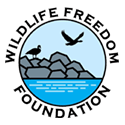Rehabilitating Wildlife
Every year the Wildlife Freedom Foundation comes to the aid of many injured, distressed or orphaned wild animals in need of immediate help. With the training, skills and devotion of our State & Federally licensed wildlife rehabilitator, hundreds of animals can be successfully rescued, rehabilitated and released back into the wild where they belong.
Wildlife rehabilitation is in no way an attempt to turn wild animals into pets. Injured wild animals are held in captivity only until they will be able to return to their independent life in the wild. Fear of humans is a necessary element for them and every effort is made to minimize human contact to prevent the domesticating/taming of the animals in need of rehabilitation. Wildlife rehabilitation is a complex and time-consuming process

Waterfowl: Angel Wing
What is Angel Wing? Angel wing syndrome, also known as airplane wing or drooped wing, is a mostly painless cosmetic deformity found primarily in aquatic waterfowl. The condition itself is not life threatening however, birds suffering from angel wing cannot fly, leaving them unable to migrate and making it harder for them to escape predators. Although information about this syndrome is limited, many in the veterinary community believe angel wing is likely caused by an unhealthy diet.
Many enjoy observing ducks and geese at a public park or waterway, these birds are perfectly capable of providing for themselves and should not be fed by humans. Bread and other processed foods trigger behind most cases of angel wing.
If signs of angel wing are caught early enough, while the bird is still young, treatment can be attempted through an immediate change of diet and wrapping the wing and binding it against the bird’s body for a few days to keep it untwisted until the bones strengthen.
A diet that provides sufficient amounts of vitamin D (the “sunshine” vitamin) and vitamin E.
Read more about: Angel Wing
Some of our work with wildlife includes reverting Angel wing in goslings:



Migratory Birds
Watch the video: Releasing of 2 Warblers after rehabilitation
Rehabilitating the Gray Squirrel


The Opossum

We are lucky to have among us the quiet, slow-moving, very clean Virginia Opossum.
The only marsupials in North America, the opossums were present on our planet when dinosaurs roamed. They are immune from rabies and should be welcome in everyone’s garden, as they consume insects, ticks, snails, slugs, beetles, cockroaches, mice and fruit and grains. They have “superpowers” against snakes. Litters average about eight and just like baby kangaroos and koalas, opossum babies stay inside the mother’s pouch to nurse and develop. After about 2 months, the babies leave the pouch and ride around on their mother’s back.
Understanding the “Playing possum” idiom: It is one of the most effective ways the opossums defend themselves. When unable to flee, when extremely frightened the opossums fall into an involuntary coma. They become stiff and their mouth will gape open. This condition might last between 40 minutes and 4 hours and most predators will abandon their attack, thinking the opossum to be dead.
Opossums do not hang by their tails but they use the tail to stabilize their position while climbing and walking. Opossums may growl, drool, and show their 50 teeth when frightened, but in reality are placid and prefer to avoid any confrontation. Because Opossums are slow-moving and easy prey, they tend to live for 1 to 2 years in the wild due to predation and/or collisions with motor vehicles. If kept in captivity they may live for up to 10 years.
“Male opossums are called “jacks” and females “jills” and babies “joeys”.
